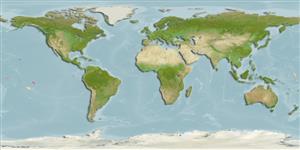>
Blenniiformes (Blennies) >
Blenniidae (Combtooth blennies) > Salariinae
Etymology: Entomacrodus: Greek, ento = inside + Greek, makros = big + Greek, odous = teeth (Ref. 45335); macrospilus: macrospilus meaning large spot, in reference its head spot (Ref. 40910).
Environment: milieu / climate zone / rango de profundidad / distribution range
Ecología
marino pelagic-neritic; rango de profundidad 0 - 8 m (Ref. 54980). Tropical
Eastern Central Pacific: Marquesas Islands. Also Western Central Pacific (Ref. 12848).
Tamaño / Peso / Age
Madurez: Lm ? range ? - ? cm
Max length : 4.2 cm SL macho / no sexado; (Ref. 54980)
Short description
Claves de identificación | Morfología | Morfometría
Espinas dorsales (total) : 13; Radios blandos dorsales (total) : 15 - 16; Espinas anales: 2; Radios blandos anales: 17 - 18. Absence of cirri on nape and supraorbital tentacle; upper lip margin completely crenulate; body coloration light brown; numerous tiny white spots and lateral series of paired (except for first and last) 7 dark reddish brown bars across body; males with black spot (almost same size as orbit) behind eye and uneven dark brown in females; males possibly with wide yellow area over branchiostegal membranes. Dorsal spines XIII, 15-16 (typically 16); anal rays typically 18, lateral line terminating below 10th and 11th dorsal spines; gill rakers 13-14 (Ref. 54980).
Body shape (shape guide): elongated.
Facultative air-breathing in the genus (Ref. 126274); Adults are found along rocky shores exposed to strong surge (Ref. 54980). Feeds on filamentous algae (Ref. 89972). Oviparous. Eggs are demersal and adhesive (Ref. 205), and are attached to the substrate via a filamentous, adhesive pad or pedestal (Ref. 94114). Larvae are planktonic, often found in shallow, coastal waters (Ref. 94114).
Life cycle and mating behavior
Madurez | Reproducción | Puesta | Huevos | Fecundidad | Larva
Oviparous, distinct pairing (Ref. 205).
Springer, V.G., 1967. Revision of the circumtropical shorefish genus Entomacrodus (Blennidae: Salariinae). Proc. U.S. Natl. Mus. 122(3582):150 p. (Ref. 40910)
IUCN Red List Status (Ref. 130435: Version 2024-2)
Threat to humans
Harmless
Human uses
Herramientas
Special reports
Download XML
Fuentes de Internet
Estimates based on models
Preferred temperature (Referencia
123201): 27.6 - 29.3, mean 28.2 °C (based on 117 cells).
Phylogenetic diversity index (Referencia
82804): PD
50 = 0.5000 [Uniqueness, from 0.5 = low to 2.0 = high].
Bayesian length-weight: a=0.00776 (0.00356 - 0.01695), b=3.00 (2.81 - 3.19), in cm total length, based on LWR estimates for this (Sub)family-body shape (Ref.
93245).
Nivel trófico (Referencia
69278): 2.0 ±0.00 se; based on food items.
Resiliencia (Referencia
120179): Alto, población duplicada en un tiempo mínimo inferior a 15 meses (Preliminary K or Fecundity.).
Fishing Vulnerability (Ref.
59153): Low vulnerability (10 of 100).
🛈
